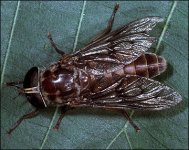♘امیرحسین♞
♘ مدیریت انجمن اسب ایران ♞
This large, bluish-black horse fly with black wings can exceed 1 inch in length and inflict a painful bite..
Large populations of horse flies (Tabanidae family) are severe pests of Missouri cattle-annoying animals and causing economic losses for farmers. Tabanus atratus is one of the most easily recognized and notorious horse flies in eastern North America.
Like many insects, the female horse fly is the bloodsucker of the family. She uses her sharp mandibles to slash a wound in the host's skin and laps up the blood. This hurts and can lead to economically significant blood loss when horse fly populations are large and their feeding pressure is severe. Horse flies can transmit cattle anaplasmosis and other blood-borne diseases in livestock.
Horse flies are adept at locating warm-blooded animals, including people near swimming pools, streams and in the woods. Apparently the flies are sensitive to parts of the electromagnetic spectrum--their sight may be like "thermal vision" cameras used to detect heat leaks in houses.
Most Missouri horse flies have aquatic larval stages. The mother affixes her eggs to vegetation near ponds and streams. The hatching larvae drop into the mud or water where they live as predators for up to several years, depending on the species. When they are ready to pupate, they move from the water to terrestrial sites and generally emerge synchronously; that is, adults of a particular species all emerge at once, which facilitates mate-finding. Horse flies seem to be present all summer long. In fact, synchronous emergences result in one species being present for a time, then being replaced by another species, and so on. To cattle, however, it means being bitten the entire summer.
Field trials have demonstrated that daily treatment of cattle with synergized pyrethrins (a natural insecticide extracted from plants of the genus Chrysanthemum) will reduce biting rates by horse flies without adversely affecting cattle. Generally, this has been feasible only for dairy cattle (and for horses) because of their high management level. Few producers are capable of, or willing to, round up beef herds every day, and even if this could be accomplished, the disruption of grazing might actually result in a greater economic loss than that caused by horse flies.
Because most horse flies are day-feeders, it is theoretically possible to protect animals and people from attack by staying inside during daylight hours. This is not practical for pastured beef cattle.
The economic equation changes, however, if cattle can be made to treat themselves. Almost 50 years ago, MU entomologists Curtis Wingo and Stirling Kyd described an economical cattle self-spraying approach that produced effective horse fly control. It will still do so today.
Large populations of horse flies (Tabanidae family) are severe pests of Missouri cattle-annoying animals and causing economic losses for farmers. Tabanus atratus is one of the most easily recognized and notorious horse flies in eastern North America.
Like many insects, the female horse fly is the bloodsucker of the family. She uses her sharp mandibles to slash a wound in the host's skin and laps up the blood. This hurts and can lead to economically significant blood loss when horse fly populations are large and their feeding pressure is severe. Horse flies can transmit cattle anaplasmosis and other blood-borne diseases in livestock.
Horse flies are adept at locating warm-blooded animals, including people near swimming pools, streams and in the woods. Apparently the flies are sensitive to parts of the electromagnetic spectrum--their sight may be like "thermal vision" cameras used to detect heat leaks in houses.
Most Missouri horse flies have aquatic larval stages. The mother affixes her eggs to vegetation near ponds and streams. The hatching larvae drop into the mud or water where they live as predators for up to several years, depending on the species. When they are ready to pupate, they move from the water to terrestrial sites and generally emerge synchronously; that is, adults of a particular species all emerge at once, which facilitates mate-finding. Horse flies seem to be present all summer long. In fact, synchronous emergences result in one species being present for a time, then being replaced by another species, and so on. To cattle, however, it means being bitten the entire summer.
Field trials have demonstrated that daily treatment of cattle with synergized pyrethrins (a natural insecticide extracted from plants of the genus Chrysanthemum) will reduce biting rates by horse flies without adversely affecting cattle. Generally, this has been feasible only for dairy cattle (and for horses) because of their high management level. Few producers are capable of, or willing to, round up beef herds every day, and even if this could be accomplished, the disruption of grazing might actually result in a greater economic loss than that caused by horse flies.
Because most horse flies are day-feeders, it is theoretically possible to protect animals and people from attack by staying inside during daylight hours. This is not practical for pastured beef cattle.
The economic equation changes, however, if cattle can be made to treat themselves. Almost 50 years ago, MU entomologists Curtis Wingo and Stirling Kyd described an economical cattle self-spraying approach that produced effective horse fly control. It will still do so today.

